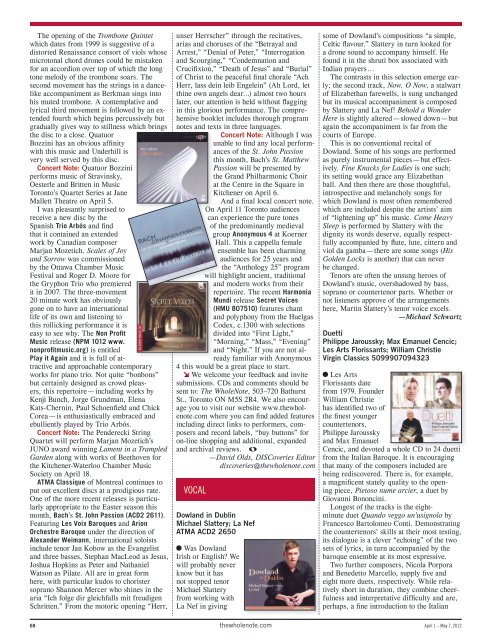You also want an ePaper? Increase the reach of your titles
YUMPU automatically turns print PDFs into web optimized ePapers that Google loves.
The opening of the Trombone Quintetwhich dates from 1999 is suggestive of adistorted Renaissance consort of viols whosemicrotonal chord drones could be mistakenfor an accordion over top of which the longtone melody of the trombone soars. Thesecond movement has the strings in a dancelikeaccompaniment as Berkman sings intohis muted trombone. A contemplative andlyrical third movement is followed by an extendedfourth which begins percussively butgradually gives way to stillness which bringsthe disc to a close. QuatuorBozzini has an obvious affinitywith this music and Underhill isvery well served by this disc.Concert Note: Quatuor Bozziniperforms music of Stravinsky,Oesterle and Britten in MusicToronto’s Quartet Series at JaneMallett Theatre on <strong>April</strong> 5.I was pleasantly surprised toreceive a new disc by theSpanish Trio Arbós and findthat it contained an extendedwork by Canadian composerMarjan Mozetich. Scales of Joyand Sorrow was commissionedby the Ottawa Chamber MusicFestival and Roger D. Moore forthe Gryphon Trio who premieredit in 2007. The three-movement20 minute work has obviouslygone on to have an internationallife of its own and listening tothis rollicking performance it iseasy to see why. The Non ProfitMusic release (NPM 1012 www.nonprofitmusic.org) is entitledPlay it Again and it is full of attractiveand approachable contemporaryworks for piano trio. Not quite “bonbons”but certainly designed as crowd pleasers,this repertoire — including works byKenji Bunch, Jorge Grundman, ElenaKats-Chernin, Paul Schoenfield and ChickCorea — is enthusiastically embraced andebulliently played by Trio Arbós.Concert Note: The Penderecki StringQuartet will perform Marjan Mozetich’sJUNO award winning Lament in a TrampledGarden along with works of Beethoven forthe Kitchener-Waterloo Chamber MusicSociety on <strong>April</strong> 18.ATMA Classique of Montreal continues toput out excellent discs at a prodigious rate.One of the more recent releases is particularlyappropriate to the Easter season thismonth, Bach’s St. John Passion (ACD2 2611).Featuring Les Voix Baroques and ArionOrchestre Baroque under the direction ofAlexander Weimann, international soloistsinclude tenor Jan Kobow as the Evangelistand three basses, Stephan MacLeod as Jesus,Joshua Hopkins as Peter and NathanielWatson as Pilate. All are in great formhere, with particular kudos to choristersoprano Shannon Mercer who shines in thearia “Ich folge dir gleichfalls mit freudigenSchritten.” From the motoric opening “Herr,unser Herrscher” through the recitatives,arias and choruses of the “Betrayal andArrest,” “Denial of Peter,” “Interrogationand Scourging,” “Condemnation andCrucifixion,” “Death of Jesus” and “Burial”of Christ to the peaceful final chorale “AchHerr, lass dein leib Engelein” (Ah Lord, letthine own angels dear…) almost two hourslater, our attention is held without flaggingin this glorious performance. The comprehensivebooklet includes thorough programnotes and texts in three languages.Concert Note: Although I wasunable to find any local performancesof the St. John Passionthis month, Bach’s St. MatthewPassion will be presented bythe Grand Philharmonic Choirat the Centre in the Square inKitchener on <strong>April</strong> 6.And a final local concert note.On <strong>April</strong> 11 Toronto audiencescan experience the pure tonesof the predominantly medievalgroup Anonymous 4 at KoernerHall. This a cappella femaleensemble has been charmingaudiences for 25 years andthe “Anthology 25” programwill highlight ancient, traditionaland modern works from theirrepertoire. The recent HarmoniaMundi release Secret Voices(HMU 807510) features chantand polyphony from the HuelgasCodex, c.1300 with selectionsdivided into “First Light,”“Morning,” “Mass,” “Evening”and “Night.” If you are not alreadyfamiliar with Anonymous4 this would be a great place to start.We welcome your feedback and invitesubmissions. CDs and comments should besent to: The WholeNote, 503–720 BathurstSt., Toronto ON M5S 2R4. We also encourageyou to visit our website www.thewholenote.comwhere you can find added featuresincluding direct links to performers, composersand record labels, “buy buttons” foron-line shopping and additional, expandedand archival reviews.—David Olds, DISCoveries Editordiscoveries@thewholenote.comVOCALDowland in DublinMichael Slattery; La NefATMA ACD2 2650Was DowlandIrish or English? Wewill probably neverknow but it hasnot stopped tenorMichael Slatteryfrom working withLa Nef in givingsome of Dowland’s compositions “a simple,Celtic flavour.” Slattery in turn looked fora drone sound to accompany himself. Hefound it in the shruti box associated withIndian prayers …The contrasts in this selection emerge early;the second track, Now, O Now, a stalwartof Elizabethan farewells, is sung unchangedbut its musical accompaniment is composedby Slattery and La Nef! Behold a WonderHere is slightly altered — slowed down — butagain the accompaniment is far from thecourts of Europe.This is no conventional recital ofDowland. Some of his songs are performedas purely instrumental pieces — but effectively.Fine Knacks for Ladies is one such;its setting would grace any Elizabethanball. And then there are those thoughtful,introspective and melancholy songs forwhich Dowland is most often rememberedwhich are included despite the artists’ aimof “lightening up” his music. Come HeavySleep is performed by Slattery with thedignity its words deserve, equally respectfullyaccompanied by flute, lute, cittern andviol da gamba — there are some songs (HisGolden Locks is another) that can neverbe changed.Tenors are often the unsung heroes ofDowland’s music, overshadowed by bass,soprano or countertenor parts. Whether ornot listeners approve of the arrangementshere, Martin Slattery’s tenor voice excels.—Michael SchwartzDuettiPhilippe Jaroussky; Max Emanuel Cencic;Les Arts Florissants; William ChristieVirgin Classics 5099907094323Les ArtsFlorissants datefrom 1979. FounderWilliam Christiehas identified two ofthe finest youngercountertenors,Philippe Jarousskyand Max EmanuelCencic, and devoted a whole CD to 24 duettifrom the Italian Baroque. It is encouragingthat many of the composers included arebeing rediscovered. There is, for example,a magnificent stately quality to the openingpiece, Pietoso nume arcier, a duet byGiovanni Bononcini.Longest of the tracks is the eightminuteduet Quando veggo un’usignolo byFrancesco Bartolomeo Conti. Demonstratingthe countertenors’ skills at their most testing,its dialogue is a clever “echoing” of the twosets of lyrics, in turn accompanied by thebaroque ensemble at its most expressive.Two further composers, Nicola Porporaand Benedetto Marcello, supply five andeight more duets, respectively. While relativelyshort in duration, they combine cheerfulnessand interpretative difficulty and are,perhaps, a fine introduction to the Italian68 thewholenote.com <strong>April</strong> 1 – May 7, <strong>2012</strong>


















